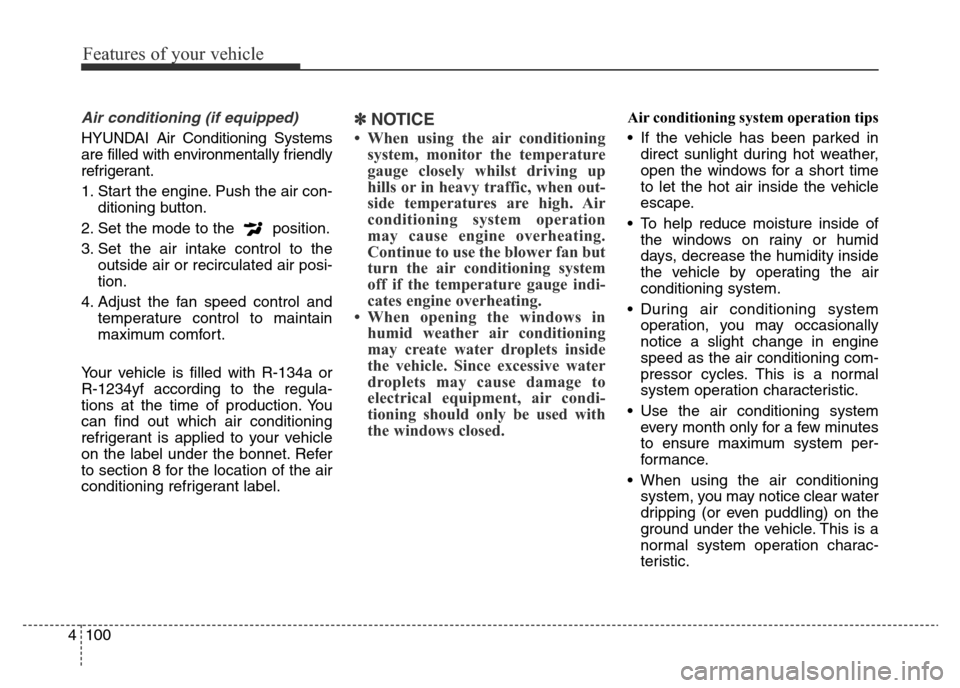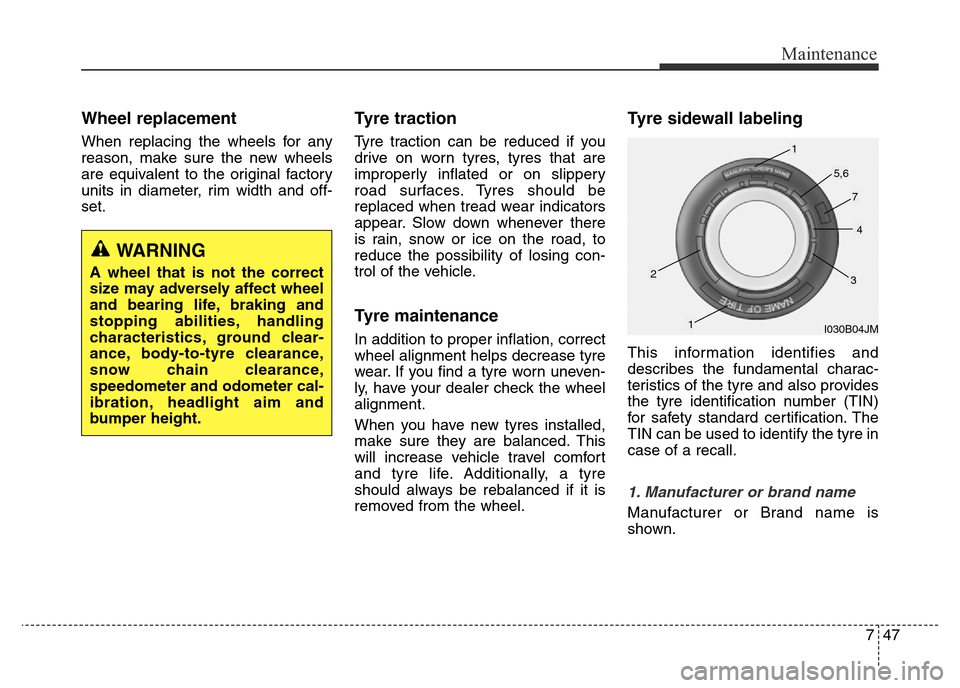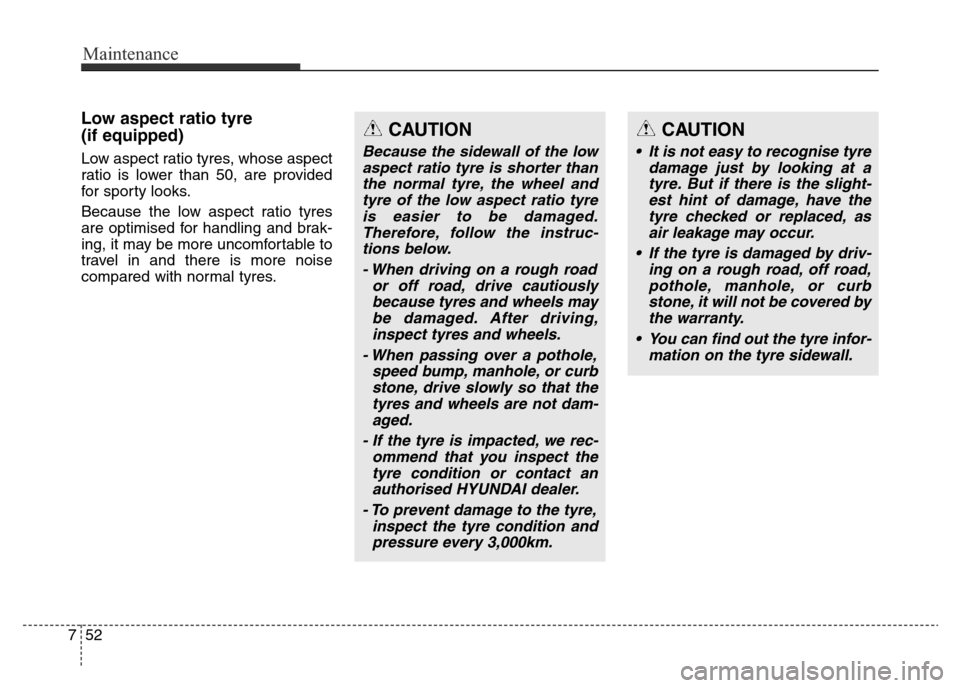Page 180 of 498

Features of your vehicle
100 4
Air conditioning (if equipped)
HYUNDAI Air Conditioning Systems
are filled with environmentally friendly
refrigerant.
1. Start the engine. Push the air con-
ditioning button.
2. Set the mode to the position.
3. Set the air intake control to the
outside air or recirculated air posi-
tion.
4. Adjust the fan speed control and
temperature control to maintain
maximum comfort.
Your vehicle is filled with R-134a or
R-1234yf according to the regula-
tions at the time of production. You
can find out which air conditioning
refrigerant is applied to your vehicle
on the label under the bonnet. Refer
to section 8 for the location of the air
conditioning refrigerant label.
✽NOTICE
• When using the air conditioning
system, monitor the temperature
gauge closely whilst driving up
hills or in heavy traffic, when out-
side temperatures are high. Air
conditioning system operation
may cause engine overheating.
Continue to use the blower fan but
turn the air conditioning system
off if the temperature gauge indi-
cates engine overheating.
• When opening the windows in
humid weather air conditioning
may create water droplets inside
the vehicle. Since excessive water
droplets may cause damage to
electrical equipment, air condi-
tioning should only be used with
the windows closed.
Air conditioning system operation tips
• If the vehicle has been parked in
direct sunlight during hot weather,
open the windows for a short time
to let the hot air inside the vehicle
escape.
• To help reduce moisture inside of
the windows on rainy or humid
days, decrease the humidity inside
the vehicle by operating the air
conditioning system.
• During air conditioning system
operation, you may occasionally
notice a slight change in engine
speed as the air conditioning com-
pressor cycles. This is a normal
system operation characteristic.
• Use the air conditioning system
every month only for a few minutes
to ensure maximum system per-
formance.
• When using the air conditioning
system, you may notice clear water
dripping (or even puddling) on the
ground under the vehicle. This is a
normal system operation charac-
teristic.
Page 442 of 498

747
Maintenance
Wheel replacement
When replacing the wheels for any
reason, make sure the new wheels
are equivalent to the original factory
units in diameter, rim width and off-
set.
Tyre traction
Tyre traction can be reduced if you
drive on worn tyres, tyres that are
improperly inflated or on slippery
road surfaces. Tyres should be
replaced when tread wear indicators
appear. Slow down whenever there
is rain, snow or ice on the road, to
reduce the possibility of losing con-
trol of the vehicle.
Tyre maintenance
In addition to proper inflation, correct
wheel alignment helps decrease tyre
wear. If you find a tyre worn uneven-
ly, have your dealer check the wheel
alignment.
When you have new tyres installed,
make sure they are balanced. This
will increase vehicle travel comfort
and tyre life. Additionally, a tyre
should always be rebalanced if it is
removed from the wheel.
Tyre sidewall labeling
This information identifies and
describes the fundamental charac-
teristics of the tyre and also provides
the tyre identification number (TIN)
for safety standard certification. The
TIN can be used to identify the tyre in
case of a recall.
1. Manufacturer or brand name
Manufacturer or Brand name is
shown.
WARNING
A wheel that is not the correct
size may adversely affect wheel
and bearing life, braking and
stopping abilities, handling
characteristics, ground clear-
ance, body-to-tyre clearance,
snow chain clearance,
speedometer and odometer cal-
ibration, headlight aim and
bumper height.
I030B04JM
1
1
23
4
5,6
7
Page 447 of 498

Maintenance
52 7
Low aspect ratio tyre
(if equipped)
Low aspect ratio tyres, whose aspect
ratio is lower than 50, are provided
for sporty looks.
Because the low aspect ratio tyres
are optimised for handling and brak-
ing, it may be more uncomfortable to
travel in and there is more noise
compared with normal tyres.
CAUTION
Because the sidewall of the low
aspect ratio tyre is shorter than
the normal tyre, the wheel and
tyre of the low aspect ratio tyre
is easier to be damaged.
Therefore, follow the instruc-
tions below.
- When driving on a rough road
or off road, drive cautiously
because tyres and wheels may
be damaged. After driving,
inspect tyres and wheels.
- When passing over a pothole,
speed bump, manhole, or curb
stone, drive slowly so that the
tyres and wheels are not dam-
aged.
- If the tyre is impacted, we rec-
ommend that you inspect the
tyre condition or contact an
authorised HYUNDAI dealer.
- To prevent damage to the tyre,
inspect the tyre condition and
pressure every 3,000km.
CAUTION
• It is not easy to recognise tyre
damage just by looking at a
tyre. But if there is the slight-
est hint of damage, have the
tyre checked or replaced, as
air leakage may occur.
• If the tyre is damaged by driv-
ing on a rough road, off road,
pothole, manhole, or curb
stone, it will not be covered by
the warranty.
• You can find out the tyre infor-
mation on the tyre sidewall.